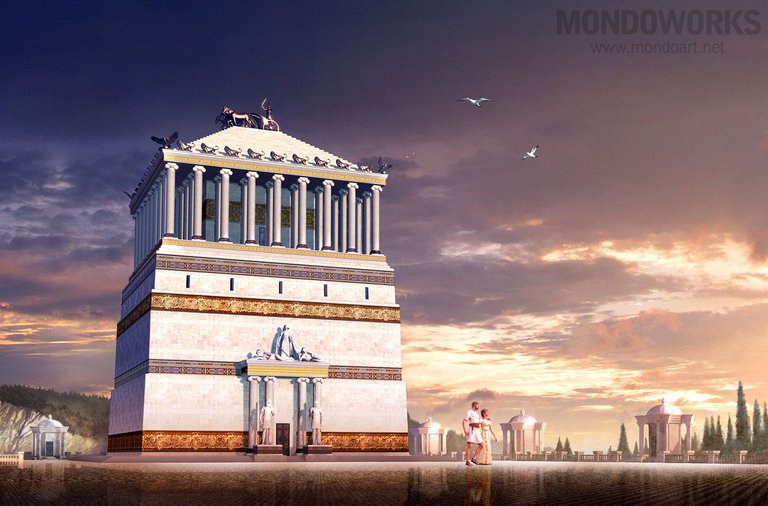
Artwork by www.mondoart.net
The Mausoleum at Halicarnassus or Tomb of Mausolus (Ancient Greek: Μαυσωλεῖον τῆς Ἁλικαρνασσοῦ; Turkish: Halikarnas Mozolesi) was a tomb built between 353 and 350 BC at Halicarnassus (present Bodrum, Turkey) for Mausolus, a satrap in the Persian Empire, and his sister-wife Artemisia II of Caria. The structure was designed by the Greek architects Satyros and Pythius of Priene. The Mausoleum was approximately 45 m (148 ft) in height, and the four sides were adorned with sculptural reliefs, each created by one of four Greek sculptors—Leochares, Bryaxis, Scopas of Paros and Timotheus. The finished structure of the mausoleum was considered to be such an aesthetic triumph that Antipater of Sidonidentified it as one of his Seven Wonders of the Ancient World. It was destroyed by successive earthquakes from the 12th to the 15th century, the last surviving of the six destroyed wonders. The word mausoleum has now come to be used generically for an above-ground tomb.
The Mausoleum of Halicarnassus resembled a temple and the only way to tell the difference was its slightly higher outer walls. The Mausoleum was in the Greek-dominated area of Halicarnassus, which in 353 was controlled by the Achaemenid Empire. According to the Roman architect Vitruvius, it was built by Satyros and Pytheus who wrote a treatise about it; this treatise is now lost. Pausanias adds that the Romans considered the Mausoleum one of the great wonders of the world and it was for that reason that they called all their magnificent tombs mausolea, after it.
It is unknown exactly when and how the Mausoleum came to ruin: Eustathius, writing in the 12th century on his commentary of the Iliad says “it was and is a wonder”. Because of this, Fergusson concluded that the building was ruined, probably by an earthquake, between this period and 1402, when the Knights of St. John of Jerusalemarrived and recorded that it was in ruins. However, Luttrell notes that at that time the local Greek and Turks had no name for – or legends to account for – the colossal ruins, suggesting a destruction at a much earlier period.
Many of the stones from the ruins were used by the knights to fortify their castle at Bodrum; they also recovered bas-reliefs with which they decorated the new building. Much of the marble was burned into lime. In 1846 Lord Stratford de Redcliffe obtained permission to remove these reliefs from the Bodrum.
At the original site, all that remained by the 19th century were the foundations and some broken sculptures. This site was originally indicated by Professor Donaldson and was discovered definitively by Charles Newton, after which an expedition was sent by the British government. The expedition lasted three years and ended in the sending of the remaining marbles. At some point before or after this, grave robbers broke into and destroyed the underground burial chamber, but in 1972 there was still enough of it remaining to determine a layout of the chambers when they were excavated.
This monument was ranked the seventh wonder of the world by the ancients, not because of its size or strength but because of the beauty of its design and how it was decorated with sculpture or ornaments. The mausoleum was Halicarnassus’ principal architectural monument, standing in a dominant position on rising ground above the harbor. *Wiki
Hi! I am a robot. I just upvoted you! I found similar content that readers might be interested in:
https://www.bing.com/knows/Mausoleum%20at%20Halicarnassus